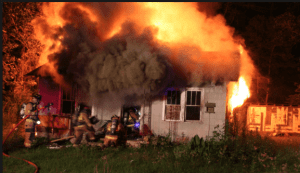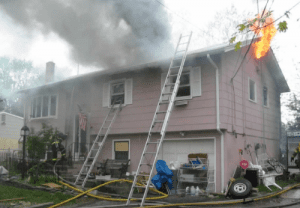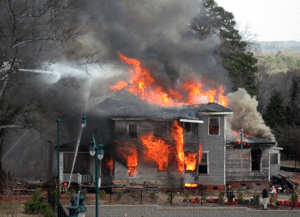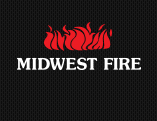 Situational awareness starts with capturing clues and cues in your environment (perception) and then understanding what those clues and cues mean (comprehension). At a structure fire, the process of capturing information should involve a complete 360-degree size-up of the scene. Many departments have policies that stipulate the completion of a 360-degree size up. Yet, for some reason, it’s not always done. This episode provides an explanation of why that might happen and how to fix the problem.
Situational awareness starts with capturing clues and cues in your environment (perception) and then understanding what those clues and cues mean (comprehension). At a structure fire, the process of capturing information should involve a complete 360-degree size-up of the scene. Many departments have policies that stipulate the completion of a 360-degree size up. Yet, for some reason, it’s not always done. This episode provides an explanation of why that might happen and how to fix the problem.
Length: 14 minutes
click the YouTube icon to listen
_____________________________________________________
If you are interested in taking your understanding of situational awareness and high-risk decision making to a higher level, check out the Situational Awareness Matters Online Academy.
CLICK HERE for details, enrollment options and pricing.
__________________________________
 Situational awareness starts with capturing clues and cues in your environment (perception) and then understanding what those clues and cues mean (comprehension). At a structure fire the process of capturing information should involve a complete 360-degree size-up of the scene. Many departments have policies that stipulate the completion of a 360-degree size up. Yet, for some reason, it’s not always done. This episode provides an explanation why that might happen and how to fix the problem.
Situational awareness starts with capturing clues and cues in your environment (perception) and then understanding what those clues and cues mean (comprehension). At a structure fire the process of capturing information should involve a complete 360-degree size-up of the scene. Many departments have policies that stipulate the completion of a 360-degree size up. Yet, for some reason, it’s not always done. This episode provides an explanation why that might happen and how to fix the problem.
I have previously written about how training sets up firefighters for success or failure. I speak to this phenomenon frequently in my safety program. Here’s an example of how first responders might be trained for failure as it relates to size ups.
While conducting a structure fire training scenario an instructor has two options for how to train firefighters about conducting a 360-degree size-up. The instructor can simply talk about completing a 360-degree size up. If this approach is taken, the firefighters will nod their heads as a sign of understanding. Some may even become frustrated because the instructor is “talking down” to the firefighters by stating the obvious. Alternatively, the instructor might require the firefighters to physically complete the 360-degree size-up by walking around the structure. Again, firefighters may become frustrated because it seems like a waste of time to walk around a structure the firefighters know so well.
Under stress, humans perform based on habits developed through repetition. Further, stress can impact the brain’s ability to comprehensively recall verbal instructions. This has been tested many times in research studies and I suspect it has played out many times at fire scenes as well. And most importantly, muscles do not learn from verbal instructions. Muscles learn from muscle movement. If the muscles aren’t moving in training, they aren’t learning.
SOLUTION
 Train firefighters for success by having them physically perform 360-degree size-ups at every training scenario. However, in order to build “Team Situational Awareness” I propose instructors add a second component to completing the size-up – communicating the size-up has been completed and a radio report of what was observed. As noted in previous articles, even the absence of clues and cues is important information to be shared to build situational awareness. The person who completes the size-up should provide a radio report that starts with “Upon completion of the 360-degree size up… (and complete the report).” As important as completing the size-up is training on what to look for and what to report.
Train firefighters for success by having them physically perform 360-degree size-ups at every training scenario. However, in order to build “Team Situational Awareness” I propose instructors add a second component to completing the size-up – communicating the size-up has been completed and a radio report of what was observed. As noted in previous articles, even the absence of clues and cues is important information to be shared to build situational awareness. The person who completes the size-up should provide a radio report that starts with “Upon completion of the 360-degree size up… (and complete the report).” As important as completing the size-up is training on what to look for and what to report.
Here are some action items to improve situational awareness:
- Ensure there is a policy that requires 360-degree size-ups.
- Ensure 360-degree size-ups are built into training evolutions… every time.
- Train firefighters on what to look for during the size-up (present AND absent clues).
- When a company officer completes a 360-degree size-up, have it announced over the radio: “Upon completion of the 360-degree size up, we have…”
DISCUSSION QUESTIONS
- Does your first arriving officer always complete a 360-degree size up? If the answer is yes, how do you know it was done?
- What clues and cues (both present and absent) would you look for while completing a 360-degree size-up to help you form a strong situational awareness about what is happening?
- What clues and cues (both present and absent) might indicate the fire should be defensive versus offensive attack?
Intro music
Safety Dance (1982)
Men Without Hats
GMC – Virgin Records
Our sponsor:
Midwest Fire
MidwestFire.com

Situational Awareness Matters! website
www.SAMatters.com
Firefighter Near Miss Reporting System
http://www.firefighternearmiss.com/
The mission of Situational Awareness Matters is simple: Help first responders see the bad things coming… in time to prevent bad outcomes.
Safety begins with SA!
Share your comments on this article in the “Leave a Reply” box below. If you want to send me incident pictures, videos or have an idea you’d like me to research and write about, contact me. I really enjoy getting feedback and supportive messages from fellow first responders. It gives me the energy to work harder for you.
Thanks,
How to reach me…
Email: Support@RichGasaway.com
Phone: 612-548-4424
Facebook Fan Page: www.facebook.com/SAMatters


